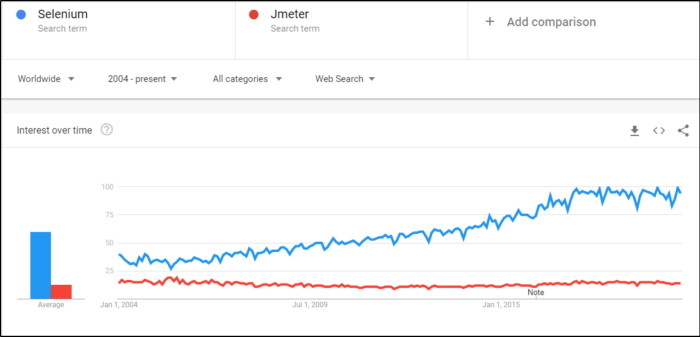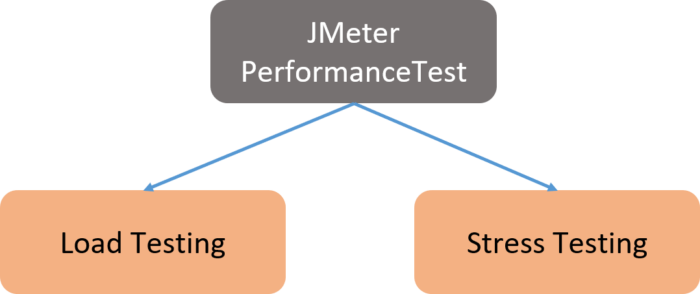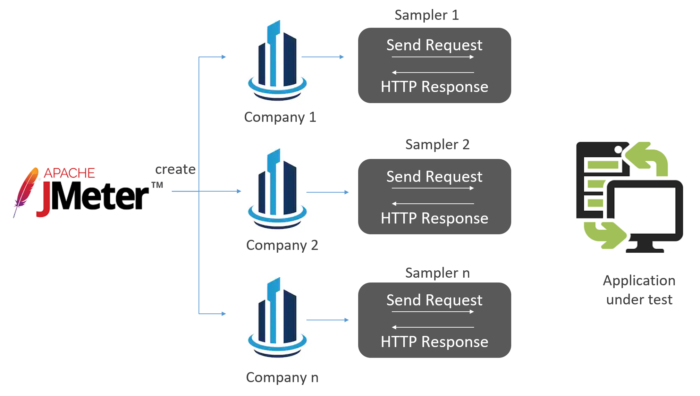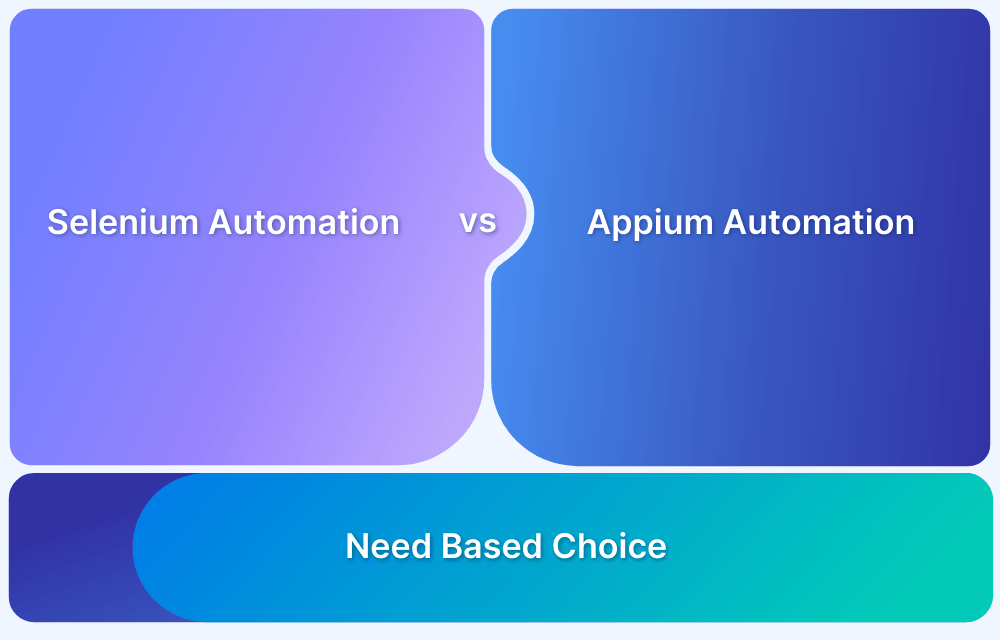JMeter vs Selenium: What is preferred by Testers?
By Neha Vaidya, Community Contributor - February 20, 2023
JMeter and Selenium are two different tools with different functionalities in the testing domain. Both these tools are useful for web application testing. In specific, JMeter is for performance testing, whereas Selenium is mainly for Automation Testing. This article will compare these tools based on their functionality and list the pros and cons of each. By doing so, it will help developers and QAs decide which tool will meet their purposes.
Why Compare Tools?
Before the comparison, let’s look at the market trends for both tools. The snapshot below represents the market interest in each tool since 2004. Clearly, the demand for Selenium so far exceeds that of JMeter.

With the advancement of test automation in development projects, choosing the right testing tool will immensely influence the test results. Therefore, it’s necessary to understand testing tools, assessments, and draw comparisons between them.
What is JMeter?
Apache JMeter is an open source Java application designed to load test functional behavior and gauge software performance. Originally designed for testing web apps, it has since expanded to include other test-related functions. Additionally, JMeter can simulate a heavy load on a server by creating thousands of virtual concurrent users to the web server.
How does JMeter perform tests?
- Creates a request and sends the request to the server
- Collects responses from the server and visualizes the details in a chart or graph
- Processes the response from the server
- Generates test results in several formats such as text, XML, JSON for the tester to analyze data
Advantages of JMeter
- Easy to use without extensive knowledge of programming. It has a user-friendly UI and one can also use CLI.
- Provides integration with Jenkins and reporting
- Easy installation on any operating system
- Key features like the Thread Group, helps to see whether software performance is good.
- Test IDE allows test recording from browsers or native applications
- Allows API testing, Database Testing, and MQ testing with ease
- When there’s a high number of TPS, one can achieve more transactions per second given the hyper-limitations.
Disadvantages of JMeter
- Automation is difficult with JMeter
- JMeter output reports are difficult to understand without training
- It doesn’t support JavaScript and AJAX requests.
- Complex applications that use dynamic content or use JS to alter requests can be difficult to test using JMeter.
- It’s difficult to get data from one place or to perform customizations.
Areas of Application: JMeter
JMeter discovers the maximum number of concurrent users that a website can handle and provides a variety of graphical analyses of performance reports.
It also includes load and stress testing as shown in the diagram below.
- Load Testing: Modeling the expected usage by simulating multiple user access to the Web services concurrently
- Stress Testing: Every web server has a maximum load capacity. When the load goes beyond the limit, the web server starts responding slowly and produces errors. The purpose of stress testing is to find the maximum load the web server can handle.
The figure below depicts how JMeter load Testing simulates the heavy load. There are multiple companies that work for a client. Each company sends a request to the client simultaneously and receives the response. Assuming that there is a heavy load of data during the response, JMeter is used to measure and test the performance of an application in such scenarios.
Before testing the performance of a web application, one should determine:
- Normal Load
- Heavy load
- Target in the test
What is Selenium?
Selenium is a framework used for automation testing of web applications. It extends wide support to a majority of browsers, operating systems, and programming languages. It also supports cross browser testing but is limited to web applications. Selenium does not support mobile application testing.
There are various components of Selenium, but the most widely used tool is Selenium WebDriver due to its manifold functionalities. To know, in detail, about the components of Selenium, kindly refer to Selenium Tutorial.
How does Selenium Webdriver perform tests?
- In a Selenium script, every statement will be converted to a URL with the help of the JSON Wire Protocol over HTTP. The URLs will be passed to the Browser Drivers.
- Every Browser Driver uses an HTTP server to receive HTTP requests. Once the Browser Driver receives the URL, it will pass the request to the actual browser over HTTP. The commands in the Selenium script will then be executed on the browser.
- If it is a POST request then there will be an action on the browser.
- If it is a GET request then the corresponding response will be generated at the browser end and it will be sent over HTTP.
Advantages
- One can build their own framework and can connect with multiple other tools that use frameworks, keywords, etc. That helps make it a stronger solution
- The Selenium Grid, allows testers to execute parallel testing. This speeds up tests and saves time
- Selenium offers users the flexibility to customize or write their own code, create their own features, etc. It is not restricted by licensing.
Disadvantages
- Does not offer enough information for personality testing
- Test maintenance is difficult due to element waits in applications using AJAX
- If proper implementation methods are not followed, testing will be slowed down
- The Selenium UI is outdated
Areas of Application: Selenium
Let’s say one wishes to perform cross browser testing of a web application with many user actions replicated on the website. For example, they need to complete form registration, verify the email address for security purposes and then log in to the website – at the same time on five browsers. In such scenarios, Selenium Webdriver is useful.
To know more about Selenium and its various use cases, explore this Selenium guide.
JMeter and Selenium Integration
JMeter and Selenium can be used together for load testing of a website. Selenium is used to perform load testing and JMeter is used to measure the performance of the same. One can measure how fast HTML pages take to load, and also check javascript and CSS performances. This is done using a combination of the graphical JMeter interface and some scripting to invoke Selenium code.
JMeter is also used in applications like Websocket. WebSocket web applications can improve browser functionalities, by adding an Enhanced Application Client
Selenium is used for testing mouse hover functions and the drag and drop feature.
JMeter vs Selenium: General Differences
| JMeter | Selenium |
| Open-source product that supports performance testing | Open source that mainly supports web browser integration testing |
| Doesn’t extend support to cross browser testing | Supports wide range of browsers for cross browser testing |
| Is best suited for performance and stress testing of applications | Is best suited for more complex testing such as production monitoring and load testing |
| Is a UI based tool without programming aspects | Is a robust programming library and not a tool |
Conclusion
JMeter and Selenium are both used for web application testing. But the main difference is that JMeter is mostly used to test the performance of web applications under load and stress. On the other hand, Selenium is best suited for automation and cross browser testing of a website. Based on what type of testing is necessary for the project, one can choose JMeter or Selenium or integrate both if that serves their purpose.





